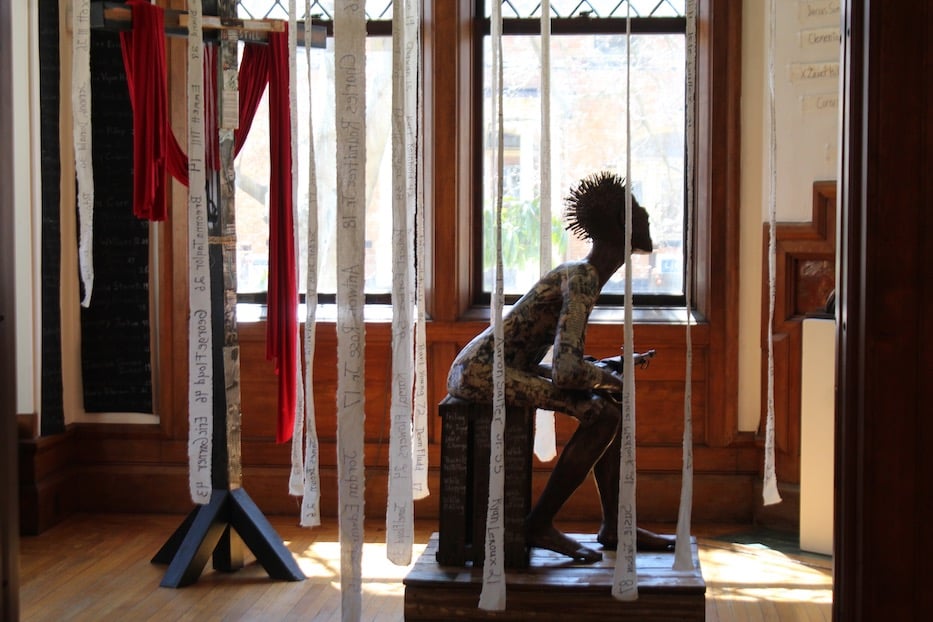
Culture & Community | East Rock | Ely Center of Contemporary Art | Arts & Culture | Arts & Anti-racism
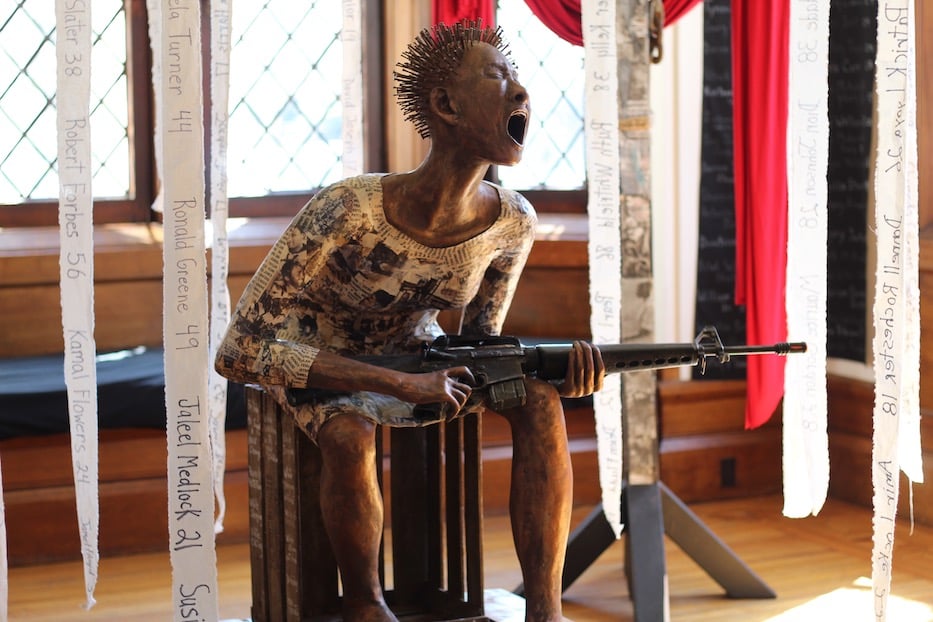
Linda Vauters Mickens’ “Redemption” installed at the Ely Center of Contemporary Art (ECoCA) at 51 Trumbull St. Lucy Gellman Photos.
The rifle seems like an impossibly heavy weight in her hands, one finger reaching for the trigger as the other steadies her whole, heaving body. Her shoulders roll forward, worn down from supporting the whole world. Her mouth is a wide O, pained as she releases a silent scream. Hundreds of names hang around her, each a life stolen prematurely. Jaleel Medlock, 21. Robert Forbes, 56. Ruth Whitfield, 86. Jeremy Southern, 22.
Through a nearby doorframe, a series of acrylic crowns slice through the air and announce their presence, impossibly bright. Flowers float on their surfaces.
Linda Vauters Mickens’ “Redemption” and Junior Charles’ “King Me” are both part of Truth In Three Colors, running at the Ely Center of Contemporary Art (ECoCA) at 51 Trumbull St. through April 30. Curated by Wábi Arts Founder Kim Weston, the show seeks to present the truth—or rather, truths—from nine artists’ perspectives and lived experiences. In the process, it reminds its viewers that there are several hundred ways to see the same object, substrate, situation or potential work.
Artists include Greg Aimé, Junior Charles, Tracie Cheng, Dooley-O, Howard el-Yasin, Bud Glick, Leonard Harmon, Linda Vauters Mickens, and Aisha Nailah.
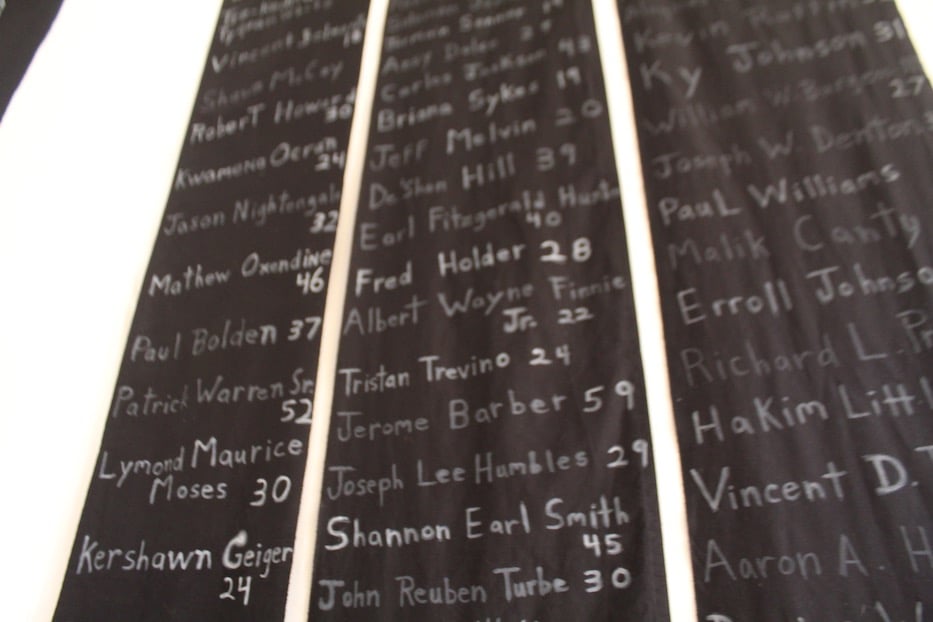
An expansion of Linda Vauters Mickens’ “Stolen” installed at the Ely Center of Contemporary Art (ECoCA) at 51 Trumbull St. Lucy Gellman Photos.
It takes place as the Ely Center itself tries to sort out and present the truth of its own situation, which has in the past three months seen failure of the board to protect staff, resignations of multiple board members and one employee. Read more about that in the New Haven Independent here and here and stay tuned for an Arts Paper article specifically about that later this week, after the second of four community conversations Wednesday night.
“We’re in a world of cancel culture, of disinformation—but the truth is the truth,” said Weston in a recent interview at the Trumbull Street space, as her triplets cycled in and out of the center’s small kitchen with questions about the work. “One plus one is two, no matter how you look at it. I wanted to make sure that I balanced this show—there’s suffering, and then there’s these moments of happiness.”
Installed across the Ely Center’s two floors, Truth In Three Colors strikes that balance many times over, and in nearly a dozen different ways. From the moment a viewer steps into the building, Mickens’ one-room installation just off the foyer stops themin their tracks, using every square inch of space available in the room. That a sun-soaked alcove waits by the window is a blessing; it is an inherently reflective space, where the sheer magnitude of Mickens’ grief is everywhere.
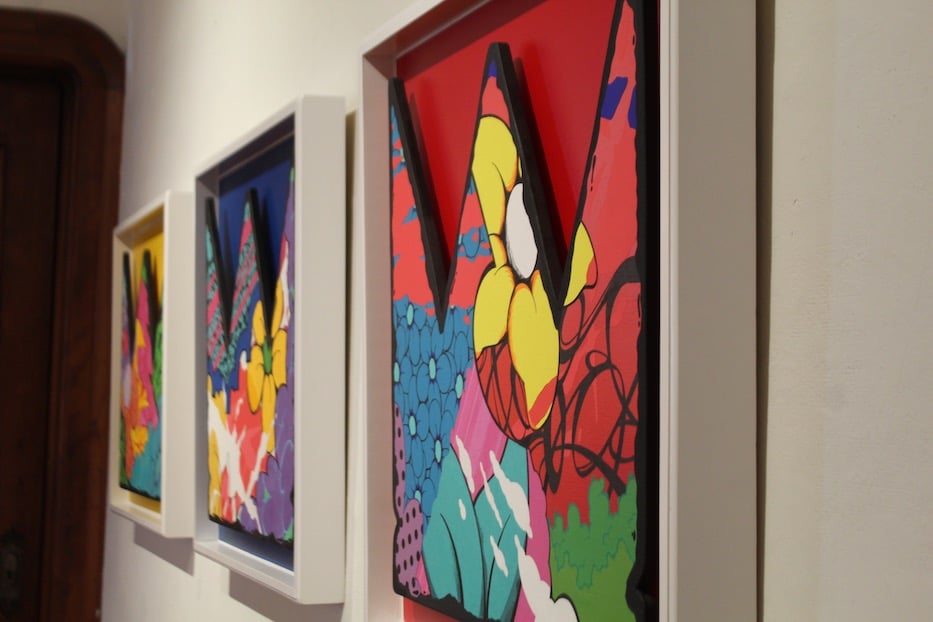
Works from Junior Charles' King Me series. Lucy Gellman Photos.
Building on work she introduced in Made Visible: Freedom Dreams earlier this year at Creative Arts Workshop, Mickens has both brought back her mixed-media sculptures “Redemption,” “Stolen” and “Cross,” and also expanded the body of work. From the ceiling and across the walls, the artist has suspended dozens of cloth strips that methodically, painstakingly list victims of police brutality, state-sanctioned violence and white supremacy from the 1950s through today.
The longer a person reads—and yes, please take the time to say their names, just as Mickens did when she was writing them—the more staggering the toll, which spans ages one to 88. Among them, a hollow, child-sized sweatshirt and pair of sweatpants stands on its own, stiffened with multiple coats of paint and glue. Its emptiness is an immediate ache, made stronger by the image of a Klansman accepting a police badge on the other side of the room. The words Protect and Serve have been replaced by Hunt and Kill in dripping red letters.
For an American viewer, it is nearly impossible to look at the piece and not think of a baby-faced Trayvon Martin, with big, soft eyes the color of melted chocolate kisses. Or Michael Brown in his green and red graduation silks, so ready for a future that he never got to live out. Or Tamir Rice, whose hands were still a child’s hands, murdered by police before his 13th birthday. Or the sons and brothers and uncles and siblings whose names viewers may not know, all bright lights, snuffed out far too soon. They are as affecting as they are effective, a reminder that while individual police may not be bad people, the institution is rotted at its core.
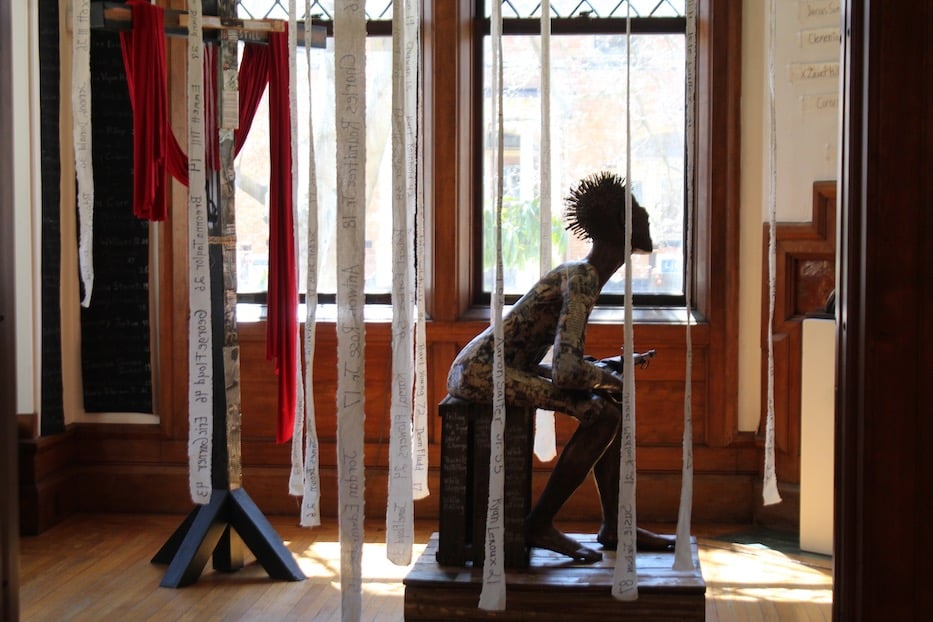
“I think it would be great if they could protect and serve instead of hunt and kill,” Mickens said at an opening reception earlier this month, adding that if she needs to call the police, she hopes she will not get an officer who sees her or any member of her family as subhuman. “I have sons. I have nephews. I have cousins.” As she made the work, she reflected on the number of families who have had to bury a loved one before their time. “How do you push and move through that?”
“How much more can we take as a people? What did we do to deserve this?” she later added. “My heart is broken and it will still be broken going forward.”
One room over, Weston has worked to balance the bitter and the sweet. If a viewer looks from “Redemption” through the open door frame, their eyes may fall most quickly on Charles’ acrylic paintings, a series of bright, floral-patterned crowns that all come from his King Me series. They mark a startling break from Mickens’ work, reminding a viewer that a whole gorgeous and complex history existed before enslavement, and before the creation of race and racism itself.
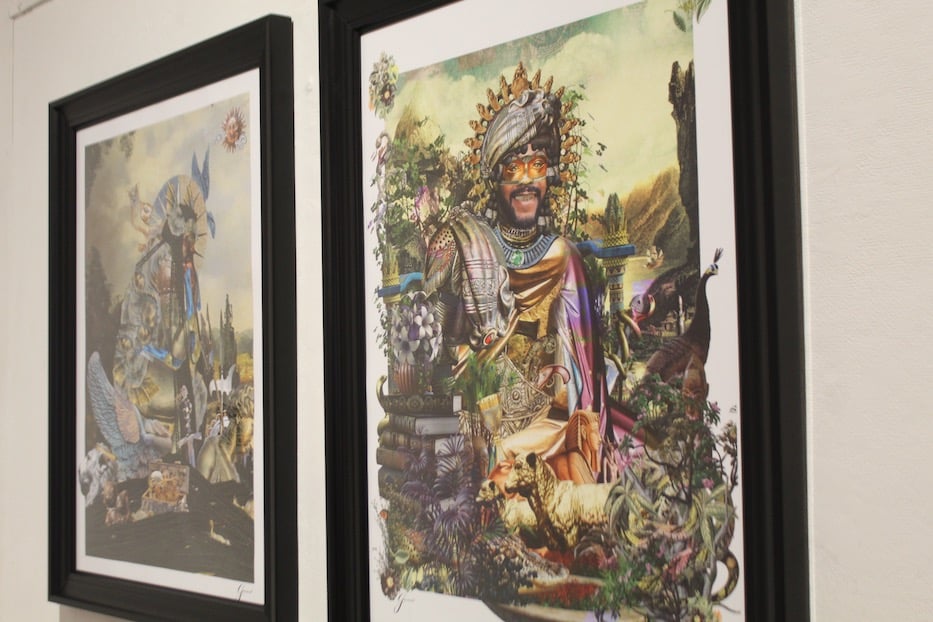
Greg Aimé's "Sir MacArthur" and "Pope Francis." The Artvive App brings the pieces to life. Lucy Gellman Photos.
Brought into a contemporary context, they are also a moving, resounding statement of resilience and the potential for joy. Charles has lived long enough to know that American history has not been kind to people, and especially to men, who look like him. And yet, he has chosen to hope. It is a humbling and generous act in this institution, whose long record of whiteness, colonialism and entitlement does not deserve any magnanimity or grace from artists of color.
Indeed, in the same way that Mickens still believes in “an art spirit”—and in the everyday angels that are with her when she creates—Charles still posits that people can be good.
To their right, Greg Aimé’s work feels like the perfect pendant. By themselves, the prints alone are striking, marrying the power, weight and history of the Black diaspora with classical and at times religious imagery. If a viewer uses the Artvive App to view the works (which in itself raises questions around the truth or truths of seeing), Aimé has added digital sound, movement, and layers of shape and color, so that the result is a little like a moving collage. The tech-averse need not fret: a QR code in the exhibition takes people directly to the app.
“I put the quiet pieces in because sometimes the truth sits back, and it is quiet, and sometimes the bigger pieces are very loud,” Weston said of the balance she was trying to strike. It seems to have worked: pieces like Charles’ and Aimé’s complement Aisha Nailah’s bright, abstract and freehanded canvases, fold in Dooley-O’s cultural history lessons, and hold space for heavier pieces, including Leonard Harmon’s 2022 “We Gave Flesh.”

Leonard Harmon’s 2022 “We Gave Flesh.” Lucy Gellman Photos.
Installed with ample room on each side, the piece reminds viewers of the twin lie on which this country was founded and is built. Before there were stolen people—of which Mickens, Aimé, and Charles all leave a reminder, in their own separate ways—there was stolen land. In the work, the knotted, gnarled roots of a tree rise through bands of color, three of them the yellow and peach of sunrise. Above the ground, the “trunk” is a stack of bright commercial labels, all with the color “Native Flesh.” Three people, two in redface, surround it.
Three glass jars below read “Bisq-Wax/Non-Firing Bisque Stain/BW 123/Native Flesh.” Across the room, his “Not Enough” sits against a white canvas, a blur of mottled, dripping and swirled color that challenges the notion of pigmentation itself.
It is a mincing-no-words kind of moment from Harmon, who is Lenape and Nanticoke. Within a single piece, he both reminds people that his body, and the bodies of his ancestors have long been treated as commodities, and are also not for sale (nor have they ever been). He is done being appropriated but not credited, valued for his land and labor but not his heritage, fetishized but never treated as fully human.

Work by Tracie Cheng. Lucy Gellman Photos.
All of these works require witness, truth-telling and reckoning. So too upstairs, as a viewer experiences Howard el-Yasin’s “Documents” and “My Mother’s Hose” for the first time alongside Cheng’s abstracted and meditative canvases. In “Documents,” el-Yasin has taken inherited, intimate objects—his late mother’s medical documents—and repurposed them, turning them into quilt-like squares of pulp with a matte medium.
Between each, intricate stitching appears, making it into a sort of quilt in charcoal grays and blacks. Every few squares, text appears, faint and unintelligible. Because the work is installed toward the center of the room, a viewer can walk around it, studying it in three dimensions. It raises question around found objects, craft, and labor seen as traditionally “domestic,” like stitching.
“It’s not meant to be read,” he said at one point during the opening reception, as he pointed out the meticulous seams holding the work together. “It’s meant to be a nod to what once was.”
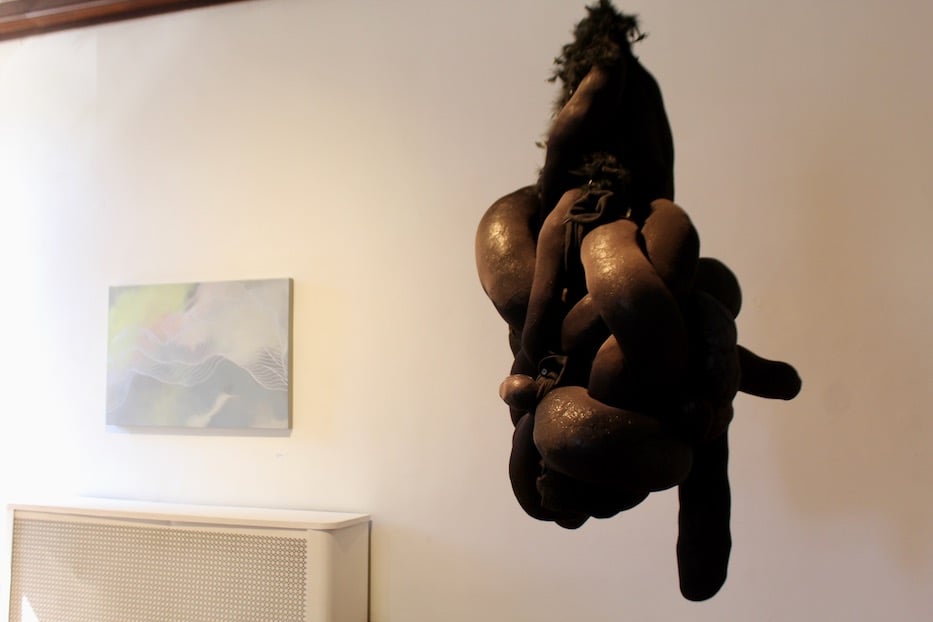
Work by Tracie Cheng and Howard el-Yasin. Lucy Gellman Photos.
Hanging across the room, “My Mother’s Hose” uses stockings from the matriarchs in his family, stretching the black nylon and spandex over black plastic stuffing that creates a glinting, sparkly shine in the Ely Center’s light. It works over multiple levels: the torque of the piece makes it feel intimate, corporeal, while the mixed media reminds viewers that there is no one shade of black. As the stuffed hose twist and furrow into each other, they seem to chatter animatedly with Cheng’s canvases, where delicate gold lines spill and wind across the page. A black feather boa, fastened at the top, seems like it has always belonged there.
They build towards an installation from the artist and photographer Bud Glick that feels like a self-contained exhibition and masterclass in narrative and visual storytelling. On a wall at the top of the stairs, a viewer is transported back in time and space, taken to the streets of Lower Manhattan.
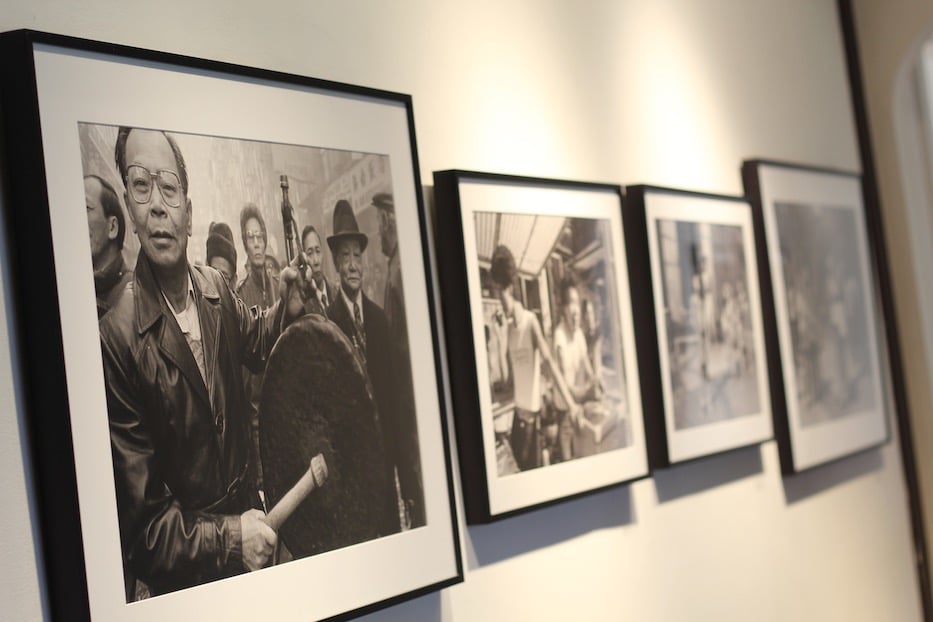
Bud Glick, Lunar New Year, Bayard Street, New York's Chinatown, 1984. Lucy Gellman Photos.
It is 1984, and Bayard Street has come alive with celebrations of the Lunar New Year. It is 1982, and a little girl in gingham and pigtails looks defiantly into the camera as a knot of kids laugh on the sidewalk behind her. It is 1983, and the Feast of San Gennaro is unfolding across Mulberry Street, where Little Italy has become background noise as Chinatown becomes more prominent.
The images, which hold struggle and joy both by the armful, come from Glick’s work documenting New York’s Chinatown as it continued to change and evolve in the early 1980s. At the beginning of the 1980s, the New York Chinatown History Project (it is now the Museum of Chinese In America) commissioned Glick to document Manhattan’s Chinatown neighborhoods. For years, he worked with colleague, collaborator and historian Yuet fung-Ho to record a layered history of labor, kinship, and anti-Asian hate that stretches from 1882 to the present.
Glick demands close looking of his viewer, and trusts them to do it too. In one image, a certain Mr. Ng hunches forward, reading a newspaper in a spare apartment. To his right, a calendar hangs on the wall, perhaps the only indication that time is passing. Around him, the air seems still, stagnant. A pot and radio are arranged neatly on a single shelf near the back of the kitchen.
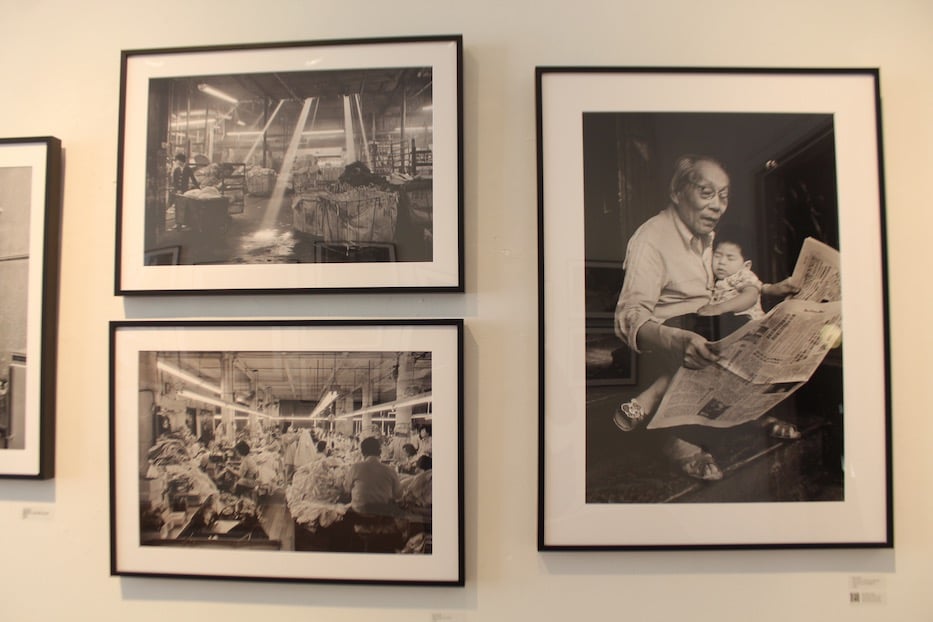
Bud Glick, Wing Gong Wetwash, Greenpoint, Brooklyn, 1981; Geolan Sportswear, 202 Center St., New York City, 1982; Kam Ho Lee with his grandson, Vincent Lee, 9 Eldridge St., 1983.
It’s only through reading the label and accompanying text that viewers learn that this is a bachelor apartment, an outgrowth of the Chinese Exclusion Act of 1882. From 1882 to 1943, the act both barred large swaths of the Chinese population from immigrating to the U.S., and forbade the few men who could from bringing their wives and children with them. Even when it ended in the 1940s, the cap on Chinese immigrants remained under 200 until the last 35 years of the 20th century.
The U.S. government issued a formal condemnation of the Act in 2012—just 11 years ago. A decade later, the image is hard to see without thinking of echoes of the Chinese Exclusion Act, from surprise bachelor apartments to Sinophobia and anti-Asian violence over the past three, five, 10 and 50 years.
But Glick, like many of the artists in the show, holds the horror and anguish of white supremacy alongside real joy and resilience. In one image, Kam Ho Lee holds his young grandson, Vincent, as he spreads a Chinese-language newspaper wide open. He is unbothered by the napping boy: a smile tugs at the edge of his mouth. As they study the two, a viewer can all but feel the weight of Vincent’s warm, sleepy head pressing softly against their shoulder.
In an accompanying label and video, Glick explains that he returned to photograph Vincent in 2019, when he was 39 years old. The two traded stories of his grandfather, who migrated to the U.S. from Cuba and could speak Spanish.

Detail. Aisha Nailah, S.T.I.L.L. Life 7. Lucy Gellman Photos.
In another, taken in 1981, business owner Frankie Wong stands outside of his Catherine Street grocery store, surrounded by hundreds of neatly stacked heads of bok choy. He smiles at something just beyond the frame, and for a moment, he is radiating light. An oral history from his now-grown son, Freeman Wong, plays in the background.
Wong was killed six years later in 1987, when gunmen opened fire on a basement on Catherine Street. It’s a reminder that he put his whole life into building a family and a life in this new home, only to not see his children grow up. In 2014, Glick connected with his son, Freeman, and was able to share images with him and reconnect with the story of his father.
Whether the works successfully create a “safe space” for both artists and viewers, which Weston said she has set out to do, feels more like an open-ended question than a done deal. Certainly, these nine artists create a dialogue with both each other and with the house, where old, sun-lit rooms lend themselves surprisingly well to the work. To ache for Mickens is to also see Glick’s portraits with new eyes; to dwell in front of a Dooley-O is more complete with a consideration of Nailah’s composition.
And at the same time, the Ely Center is still a historically white space, where Weston—an artist and curator who is both Black and Native—has been asked to clean up the mess left by a white-led board that couldn’t be bothered to write an HR handbook. Curator Nico Wheadon has postponed her show Embodied Knowledge until this summer “to allow space for institutional reflection and repair on a number of critical issues affecting artists and culture workers in New Haven, with whom I stand.”
After a vague initial “creative conservation” held on the first night of Passover, it remains to be seen what the other three will entail, and how much transparency they will include. Weston isn’t ruffled about that, she said: she welcomes the feelings that may flood the space.
A second “community conversation” will take place Wednesday April 12 from 4:30 p.m. to 6 p.m. To register for that conversation, a Zoom event that will include Weston and Rev. Kevin Ewing, email info@elycenter.org or click here. The center has also made an anonymous survey available here.

